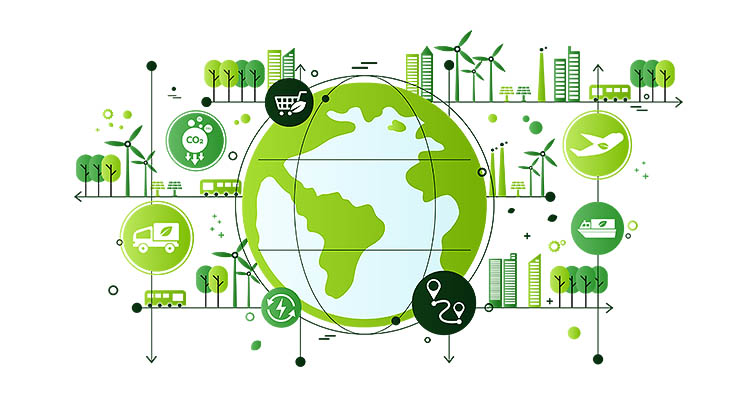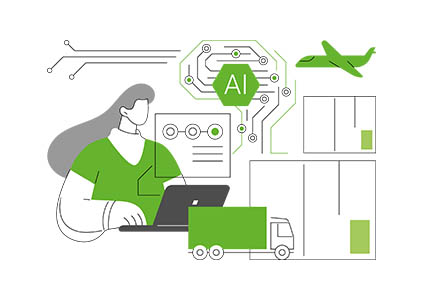A services-led approach to supply chain sustainability
Managing the retail supply chain has become increasingly challenging in the face of labor shortages, changing consumer behavior, and logistical complexity. New technologies to automate retail business processes and workflows are being implemented throughout the enterprise. From last-mile solutions that address labor and supply chain challenges in warehouses, distribution centers, market fulfillment and logistics centers, to material handling technologies, such as robotics storage and retrieval solutions, self-checkout point of sale, and other technologies, all of these automate critical workflows in the front and back of the store.
According to the World Business Council for Sustainable Development, retail supply chains are responsible for 25 percent of global greenhouse gas emissions. Beyond driving cost-efficiencies, speed and resilience, technology can also help retailers advance their sustainability initiatives and reduce the impact of supply chain operations on the environment when properly implemented.
Prevention is the best medicine
Initially deployed to help track inventory, the rapid expansion of IoT technologies now impacts everything from personalization to checkout. Gartner estimates the IoT market will nearly double by 2028, with software and IT services that help organizations manage IoT solutions as the fastest growing technology segment. Being able to remotely monitor, manage and remediate any issues with IoT devices can prevent dispatching a technician to resolve any technology issues, which can significantly reduce environmental impact by eliminating need for travel, transportation requirements, etc. In fact, IoT platform providers report a 17 percent reduction in on-site visits.
Preventative maintenance and service desk support can also help maintain healthy operation of IoT devices and increase first-time resolution, minimizing the need for on-site intervention and the related emissions. It can also improve the availability and uptime for the technology in place, which is paramount for retailers to effectively manage their supply chains.
Right part, right place, right time
Efficiently maintaining technology also requires proactive forecasting to ensure the right spare parts are on hand to fix things quickly. Optimizing parts inventory means you don’t need to house as many spare components for a given piece of equipment, reducing the labor and space that goes into producing underutilized or wasted parts.
Looking at the full lifecycle of technology throughout the supply chain by recycling, reducing and repairing can also reduce environmental impact by breaking down end of life systems and refurbishing or repairing them so they can go back into service instead of sending them to landfill.
Knowledge is power 
Getting the most from technology requires proper usage. Unfortunately, we often find underutilization due to inadequate or inconsistent training. This lack of training can be extraordinarily challenging to provide for a workforce whose turnover rates are among the top industries and continuing to rise, hovering at about 85 percent for part-time hourly store employees. Unable to keep pace with staff turnover, coupled with the pace of technology updates and releases, retailers are not optimizing their investment in technology meant to automate various points within the supply chain.
For example, we see increasing interest in and potential applications for robotics in distribution and inventory management, but these devices are still reliant upon human operators whose training is often one and done. Programmatic, ongoing training is key to ensuring staff are equipped to leverage technology to its full potential and benefit.
Strength in numbers
Indirect, or Scope 3 emissions, include those generated across the value chain by suppliers who contribute to the production and transportation of products. These emissions account for 90 percent of retailers’ greenhouse gas emissions according to the National Retail Federation yet are difficult to track due to lack of data.
While the SEC has not yet included Scope 3 reporting as part of its climate disclosure rules, California recently became the first state to pass legislation requiring companies to report Scope 3 emissions. Being able to quantify the impact of partners and suppliers up and down the supply chain not only prepares retailers to meet growing regulatory requirements around reporting carbon emissions, but provides insight into how prevention, monitoring and training can further support a sustainable supply chain.
Clearly, many opportunities exist to advance sustainability and improve operational efficiency throughout the retail supply chain. From ensuring optimal implementation through design and planning at the outset, to minimizing the need for human intervention throughout the product lifecycle via remote resolution, to taking a programmatic approach to ongoing training for heightened adoption, retailers can minimize their environmental impact while maximizing their success.
By Jim Kirby
For a list of the sources used in this article, please contact the editor.
Jim Kirby is Vice President Service Advantage at Ricoh North America. Ricoh is a leading provider of integrated digital services and print and imaging solutions designed to support digital transformation of workplaces, workspaces and optimize business performance.
Headquartered in Tokyo, Ricoh’s global operation reaches customers in approximately 200 countries and regions, supported by cultivated knowledge, technologies, and organizational capabilities nurtured over its 85-year history.

